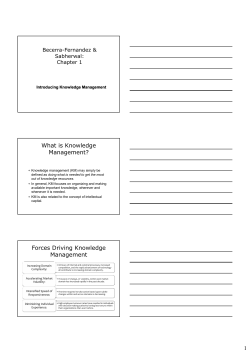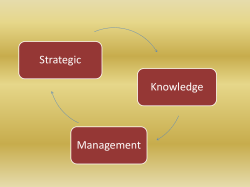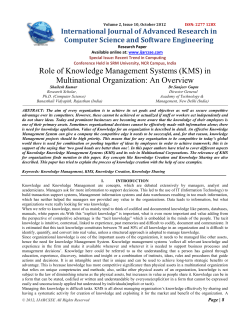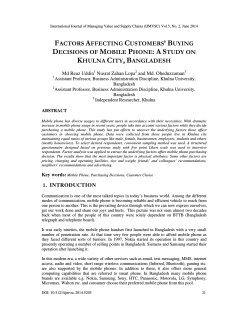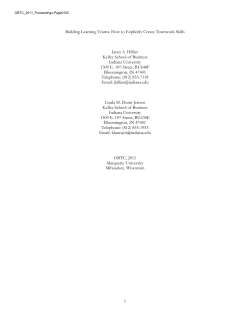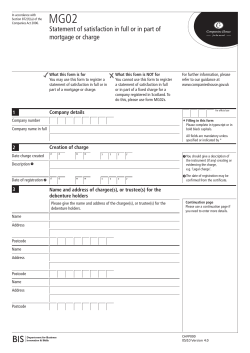
Document 200926
European Management Journal Vol. 23, No. 3, pp. 263–273, 2005 Ó 2005 Elsevier Ltd. All rights reserved. Printed in Great Britain 0263-2373 $30.00 doi:10.1016/j.emj.2005.04.004 How to Support Knowledge Creation in New Product Development: An Investigation of Knowledge Management Methods MARTIN HOEGL, WHU – Otto Beisheim Graduate School of Management, Germany ANJA SCHULZE, University of St. Gallen, Switzerland Knowledge management methods need to be selected depending on the purpose for which knowledge is ‘being managed’. In this article, purpose is considered in terms of encouraging knowledge creation in new product development (NPD) projects. Given that companies have started to deploy a number of knowledge management methods in support of NPD efforts, the central aim of this research is to investigate how ten such methods support knowledge creation during the development of new products. We provide evidence from a survey of 356 responses of members of 94 NPD projects on the utilization of (and satisfaction with) 14 knowledge management methods. The 10 highest rated knowledge management methods (in terms of satisfaction) are discussed in more detail, explaining how they operate to support knowledge creation in NPD projects, and illustrated with examples from companies such as ABB, Siemens, BP Amoco, Volkswagen, IBM, HP, and others. Moreover, we highlight ways to evaluate the contribution of such knowledge management methods. Ó 2005 Elsevier Ltd. All rights reserved. European Management Journal Vol. 23, No. 3, pp. 263–273, June 2005 Keywords: Knowledge management, Knowledge creation, New product development Knowledge management methods need to be selected depending on the purpose for which knowledge is ‘being managed’. In our investigation, purpose was considered in terms of encouraging knowledge creation in new product development (NPD) projects. As such, this article goes beyond a large and growing literature on knowledge management pertaining to the capturing, locating, transferring, and sharing of primarily existing knowledge (von Krogh, Ichijo, & Nonaka, 2000). By contrast, our research addresses the question of creating new knowledge to support new product development in organizations (see Figure 1). Although the first and second steps in Figure 1 stress the exploitation of existing knowledge or the dissemination of new knowledge, most beneficial for innovation and NPD is the creation of new knowledge (Armbrecht Jr. et al., 2001). As Ruggles (1998) states: 263 Process oriented HOW TO SUPPORT KNOWLEDGE CREATION IN NEW PRODUCT DEVELOPMENT ment of knowledge management activities and knowledge management results. 33 Creating and Enabling Which Knowledge Management Methods are Deployed in NPD Projects, and how Satisfied are Companies with Them? 22 Content oriented Transferring and Sharing Based on an extensive literature review and a series of interviews with practitioners, 14 knowledge management methods were selected for consideration in this study. All of these methods met the following three selection criteria: 11 Capturing and Locating Existing knowledge New knowledge Figure 1 Evolution of Knowledge Management Initiatives; figure based on von Krogh et al. (2000) ‘‘While the ever-popular efforts involving capture, access, and transfer of knowledge can lead to increased efficiency, knowledge generation is the key to growth.’’ Consequently, managers face the challenge of identifying and selecting those knowledge management methods that enable the organization to reach and to excellently perform the third stage of the evolution of knowledge management initiatives, i.e., creating and enabling. Given that companies have started to deploy a number of knowledge management methods in support of NPD efforts, the central aim of this research is to investigate how ten such methods support knowledge creation during the development of new products. The remainder of this article divides into three parts. First, we provide evidence from a survey of 356 responses of members of 94 NPD projects on the utilization of, and satisfaction with, 14 knowledge management methods. In particular, we investigated (1) which knowledge management methods companies are familiar with, (2) which of these methods they actually deployed, and (3) to what level of satisfaction. The vast majority of respondents were NPD project managers, product managers, or R & D directors. Second, in the main part of this paper, we explain how the 10 highest-rated knowledge management methods (in terms of satisfaction) operate to support knowledge creation in NPD projects. In doing so, we provide case examples from companies such as ABB, Siemens, BP Amoco, Volkswagen, IBM, HP, and others, that participated in our research. Third, we close by highlighting ways for assessing the value contribution of such knowledge management methods. Specifically, we discuss the assess264 v well known and widely used, v perceived as nurturing knowledge creation activities, and v applicable in NPD projects. It is important to note that the methods are not completely distinct but rather characterized by some overlap in terms of structure and objective. We sent out a total of 376 questionnaires to members of 94 NPD projects in 33 companies in Germany, Austria, and Switzerland. Of these, 356 usable questionnaires were returned, for a response rate of 95%. Listing the 14 knowledge management methods, we asked the respondents to evaluate their level of satisfaction with each, as well as well as the frequency with which these methods were deployed in their organizations. The respondents answered on a fivepoint ratings scale (satisfaction: ‘‘not satisfied’’ to ‘‘very satisfied’’; deployment: ‘‘not at all’’ to ‘‘very frequently’’). The respondents had the option to tick a check box if they were not familiar with a particular knowledge management method. Figure 2 displays all of the selected knowledge management methods and the percentage of the respondents of the survey that were familiar with them. Story telling, knowledge maps, and knowledge broker are known least. Reasons for that are manifold. Story telling, for example, is a relatively new and elaborate method. Moreover, the knowledge management methods known can be distinguished as two groups: those that are known and deployed, and those that are known, but not deployed. The data further indicate that those methods that are deployed by the majority of those who know them are generally considered effective (i.e., companies are satisfied with them). Also, it is possible that those methods that are known but largely not deployed did not prove successful. Respondents who actually deployed a particular knowledge management method provided data on their satisfaction with that method in support of a specific NPD project. Data analysis shows consistency with our previous reasoning. The more often European Management Journal Vol. 23, No. 3, pp. 263–273, June 2005 HOW TO SUPPORT KNOWLEDGE CREATION IN NEW PRODUCT DEVELOPMENT Informal events Experience workshops Experience reports Data bases Research services Project briefings Expert interviews Communities of practice Best practice cases Electronic discussion forums Index services Knowledge broker Story telling Knowledge maps 0% 10% 20% 30% 40% 50% Known and deployed 60% 70% 80% 90% 100% Known but not deployed Figure 2 Familiarity and Deployment of Knowledge Management Methods for All Project Phases in % of all Responses (N = 356) a method was rated as known but not deployed in projects, the lower the level of satisfaction from respondents who actually did use the method (see Figure 3). other hand, almost half of all respondents are familiar with electronic discussion forums, yet do not deploy them. Accordingly, those who currently deploy this method are not very satisfied with it. Overall, the frequency of deployment relates negatively to the level of satisfaction. E.g., experience workshops are known but not deployed by only a small percentage of respondents. Those who do deploy this method are above average satisfied with it. On the Especially interesting and a possible starting point for further investigation are methods that show divergence from this relationship, e.g., knowledge broker or expert interviews. Those deploying the method are very much satisfied with it, while there are a fair 5 very satisfied 100% 90% 80% 4 70% 60% 3 50% 40% 30% 2 20% 10% Known but not deployed Electronic discussion forums Knowledge maps 1 not satisfied at all Knowledge broker Story telling Index services Research services Best practice cases Expert interviews Data bases Experience reports Project briefings Communities of practice Experience workshops Informal events 0% Level of satisfaction when deployed Figure 3 Level of Satisfaction with Methods Deployed and Percentage of Respondents that are Familiar with the Methods but do not Deploy Them European Management Journal Vol. 23, No. 3, pp. 263–273, June 2005 265 HOW TO SUPPORT KNOWLEDGE CREATION IN NEW PRODUCT DEVELOPMENT amount of respondents that know about the method but do not deploy it. Further, companies must ask themselves whether instruments like knowledge maps or electronic discussion forums are to be deployed, since the satisfaction level is relatively low. bined, edited, and processed to form new, more complex and systematic sets of explicit knowledge. In the third step, the new explicit knowledge is disseminated among the members of the organization. Combination gives rise to systematized explicit knowledge, such as explicitly stated technologies, product specifications, or manuals. How do Knowledge Management Methods Affect Knowledge Creation in NPD Projects? Internalization is the process of absorbing explicit knowledge, thus creating new individually held tacit knowledge (Nonaka et al., 2000). There are principally two different ways that lead to the absorption of explicit and thus the creation of tacit knowledge: (1) through personal encounters in which knowledge is generated from ‘real world experiences’, e.g., dayto-day work, learning-by-doing; and (2) through simulation and experimentation in which knowledge is generated from the ‘virtual’ or ‘simulated world’, e.g., trial-and-error (Helfat & Raubitschek, 2003; Leonard & Sensiper, 1998). The following discussion explains how the top 10 (by level of satisfaction) knowledge management methods affect knowledge creation in NPD projects. In doing so, we build on qualitative evidence and case examples from the participating companies. Moreover, in detailing our arguments, we use the conceptualization of organizational knowledge creation as proposed by Nonaka and several co-authors (Nonaka, Byosiere, Borucki, & Konno, 1994; Nonaka & Takeuchi 1995; Nonaka, Toyama, & Konno, 2000). These authors specify four knowledge creation modes as the processes of interplay between explicit and tacit knowledge which lead to the creation of new organizational knowledge: socialization (tacit to tacit), externalization (tacit to explicit), combination (explicit to explicit), and internalization (explicit to implicit). Socialization yields new tacit knowledge that is built through informal interaction between individuals, i.e., through an exchange of tacit knowledge, which contributes to the enhancement of technical understanding and mental models. It occurs by spending time together, making joint hands-on experiences, or working in the same environment. Socialization may also occur in informal social meetings (even outside the workplace) between members of an organization or beyond organizational boundaries with its customers, suppliers, and affiliated firms. Externalization is an act of codifying or converting tacit knowledge into explicit knowledge, characterized by more formal interactions (such as expert interviews) and activities (such as the documentation of lessons learned from a project). In order to make externalization possible, reflection is necessary. Likewise, ‘‘Written speech is possible only after internal speech is well developed’’ (Nonaka et al., 2000). The articulation of knowledge, in effect, calls for abstraction and codification (Boisot, 2002). Combination refers to the process by which sense is made of the relations between previously unrelated knowledge domains. Such activity has been called ‘‘lateral or kaleidoscopic thinking’’ (Kanter, 1988). It consists of three steps: First, explicit knowledge (such as a best practice report from a related project) is acquired from inside and outside the organization. Second, the collected bodies of existing explicit knowledge are synthesized. They are sorted, com266 Most knowledge management methods can support several knowledge creation modes. This is advantageous both in terms of efficiency and employee acceptance of the methods, as a concentration on a small number of methods (e.g., four or five) promises a higher level of acceptance and utilization than the deployment of a larger number of methods. Each knowledge management method requires an understanding of the method and its utilization as well as different processes and activities to deploy the method. Moreover, the higher the number of knowledge management methods in use, the lower may be the usage of each method. Below, we discuss the 10 knowledge management methods following the same three-part structure for each: 1. A general description of the method and its objective. 2. An illustration with practical examples of the method’s application in companies (in italic font). 3. A discussion of the method’s contribution to knowledge creation activities and to the success of NPD projects. Since the objective of this paper is to discuss how knowledge management methods support knowledge creation in NPD projects, each method will be introduced rather briefly. A more extensive description of the methods can be found in the literature (e.g., Dougherty, 1992; Probst, Raub, Romhardt, & Doughty 1999; von Krogh, Ichijo, & Nonaka 2000; Baumbach & Schulze 2003; Schulze, 2004). Informal Events Informal events in a firm are all kinds of events which are meant to encourage conversation, open commuEuropean Management Journal Vol. 23, No. 3, pp. 263–273, June 2005 HOW TO SUPPORT KNOWLEDGE CREATION IN NEW PRODUCT DEVELOPMENT nication, and informal knowledge sharing. The deployment of this knowledge management method enhances interaction with one another, activates informal discussions and the transfer of tacit knowledge between team members, and thereby socialization (Leonard and Sensiper, 1998). At Phonak, a worldwide leader in digital hearing instruments, a whole series of events takes place throughout the year, where people can get to know each other informally. These include company days out, bicycle tours or barbecues. On average, such events take place every six weeks, initiated and organized by the individual locations and attended by the staff at each particular location. In addition, the entire company workforce comes together from all locations in a two-year cycle. This is at considerable cost to the company, which has recognized that the expenditure is worthwhile in view of the personal networks built and the resulting exchange of knowledge. A certain level of personal intimacy is necessary to establish comfortable communication of tacit knowledge (Leonard and Sensiper, 1998). By providing an extended field for interaction among organizational members for sharing ideas and perspectives, and for establishing dialog by informal internal events, socialization is initiated and encouraged. It nurtures mutual confidence, enables teams to arrive at new insights and/or more accurate interpretations than if individuals were left to decipher information on their own (Alavi & Leidner, 2001). As a result of this, performance of the technical development of a project is likely to improve. Experience Workshops In experience workshops people from the project team take a retrospective view and address the questions of what could be learned from the project, how they judge the project’s success (or lack of success) and what could be learned in order to improve subsequent projects. The objective is the exchange of experiences among the project team members. In this knowledge management method emotion is also important. ‘‘As far as knowledge management is concerned, it is more useful to the understanding of knowledge to recognize the wholeness of human experience. Whether intuition, cleverness, savvy knowing, and the expertise that combines different kinds of knowledge can be taught or captured in a knowledge management program is debatable. However, experience workshops contribute to the sharing of those important aspects.’’ (McInerey, 2002). A retrospect meeting at BP Amoco is facilitated by somebody external to that project team. In the meeting the following questions are discussed and answered: What was the objective of the project? What did we achieve? What were the successes? Why? How can we repeat the success? What were the disappointments? Why? How European Management Journal Vol. 23, No. 3, pp. 263–273, June 2005 can we avoid not to repeat them in the future? Everybody’s opinion will be taken into consideration, which means everybody’s experience and knowledge will be captured. Results of that meeting are not shared outside the team unless the team is comfortable with it. Sometimes the team might have removed things, e.g., certain quotes. Retrospects are used when a projects duration is at least three months. During an NPD project employees gather a vast amount of experiences and tacit knowledge. The tacit knowledge comprises technical knowledge but also personal knowledge about relationships, team structures etc. Talking about this purposefully and reflecting on such experiences and the according knowledge contributes to its articulation. Hence, experience workshops contribute to the advancement of externalization. This knowledge creation activity is especially encouraged, when the outcomes and the essential insights of the workshop are written up in a brief document. Communities of Practice Communities of practice are groups of people who share a concern, a set of problems, or a passion about a topic, and who deepen their knowledge in expertise in this area by interacting on an ongoing basis. E.g., engineers who design a certain kind of electronic circuit find it useful to compare designs regularly. The work of communities may result in the creation of tools, generic designs, manuals – or simply in a tacit understanding that community members share. This is not merely instrumental for their work. It also aides the personal security and satisfaction of knowing that colleagues understand each other’s perspectives, and of belonging to an interesting group of people (Wenger, McDermott and Snyder, 2002). The objectives of members of Volkswagen’s Lab Expert Network are to share experiences and to create global standards. Apart from knowledge exchange, Volkswagen noticed another positive effect: The analysis of the questions discussed in the network reveals competencies and knowledge gaps of the firm. Consequently, it is possible to take specific measures to increase employees’ qualifications and hence the firm’s competitiveness. Community experience allows employees to ‘crosspollinate’ their ideas between products and industries (Hargadon & Sutton, 1997). Combination of different parts of explicit knowledge is encouraged, when, e.g., interesting technical approaches discovered by members are forwarded to other members. Nonaka and Takeuchi emphasize this when they refer to combination and state that ‘‘Creative uses of computerized communication networks and large scale databases facilitate this mode of knowledge conversion.’’ (Nonaka and Takeuchi, 1995). In 267 HOW TO SUPPORT KNOWLEDGE CREATION IN NEW PRODUCT DEVELOPMENT developing a body of common knowledge practices, personal relationships and established ways of interacting, community members may also develop a common sense of identity (Wenger et al., 2002). Moreover, dialog among individuals with different perspectives is supported. As such, the quality and frequency of knowledge creation is improved by supporting socialization, since the interaction of community members can barely take place without the involvement of tacit knowledge. Project Briefings Project briefings are suggested to be applied before new projects start. Therein, experienced employees pass on their knowledge and experiences from prior projects to team members of the current project or the newly-begun project. The transfer of knowledge usually takes place in workshops. Some of these are structured, following a certain procedure. Others are unstructured. Knowledge is shared by pointing out issues that are considered important by the more experienced people. The knowledge transferred is highly relevant technical knowledge. Additionally, an effective project briefing communicates the expected attainment of current project members with respect to time, cost, and quality, e.g., for a product development project. Before a new project is started, employees at BP conduct a project briefing, which they call Peer Assist. The team of the starting project will select and invite people to Peer Assist, who have experience in the relevant field. In a first step of the briefing a list is compiled showing what the experienced group knows and how much the new group already has knowledge about. Usually, there is a gap. Subsequently, the experienced group will pass on relevant knowledge to the team of the starting project. In addition to this, thought is given to ideas on how to create knowledge and accomplish results beyond that of former projects. Next steps to achieve the determined objectives are defined. Project briefings are highly effective in terms of knowledge creation. The experienced team will contribute, e.g., experiences or documents about actions and events of previous projects. The new team takes this knowledge and combines it with the new requirements. Hence, the sharing of the explicated experiences, or the documents and their integration with functional specifications of the starting development project will lead to combination. Expert Interviews Often, experts do not have the skill to formulate their technical knowledge so it is understandable to others working in a different, but related field. Another 268 issue is that the time that experts spend working in their specific field is regularly more valuable to the firm than time spent on writing reports. An effective knowledge management measure that can be used to overcome these issues is the expert interview. Thereby, the dynamic attributes and the subjective nature of knowledge puts high demands on those who elicit, codify, and transform the expert’s knowledge into a sharable format. Instead of clear-cut rules, experts often have heuristics – rules of thumb – that they find useful in the exercise of their abilities. Such heuristics, although not completely describing the execution of an expertise, are often useful to others. Capturing and explicating such heuristics, when available, is a challenge facing the interviewer (Davenport & Prusak, 1998; McInerey, 2002; Probst, Raub, Romhardt, & Doughty, 1999). ABB Switzerland deploys exit interviews when an employee with expertise retires. These are a main element of the firm’s ‘exduction program’, which is a reversal of ABB Switzerland’s introduction program and which seeks to keep valuable knowledge in the company. The vision is that knowledge must not be lost when an employee leaves the company. The structured interviews follow a standardized procedure, and a form that has to be filled in serves as a guideline. Expert interviews significantly foster externalization, because the tacit knowledge of experts is articulated and often transferred into written documents by the formulation of the captured knowledge pieces. By the utilization of interviews, recording and reporting the knowledge which was newly developed by engineers in the technical development phase will be beneficial for creating further new knowledge by other members of the organization, e.g., employees in manufacturing or members of the launch team. Best Practice Cases Best practices are recommended as an effective way to handle repeating problems or to conduct repeating processes. The transfer of best practices connotes the firm’s replication of practices that are performed in a superior way and is deemed superior to alternate practices. In order to indicate best practices, several common and good practices have to be compared. The tasks that have been executed most successfully then form the foundation for the establishment of a set of best practices. Best practice descriptions include a statement of the problem being solved, the circumstances that are relevant to the case, the steps one has to go through in the solution of the problem, and the specification of useful information required to fulfill the task and reach the outcome. Best practices are not limitlessly valid. Rather, the context on which the cases are based and the context in which they are to be applied should be similar. Further, they European Management Journal Vol. 23, No. 3, pp. 263–273, June 2005 HOW TO SUPPORT KNOWLEDGE CREATION IN NEW PRODUCT DEVELOPMENT are not eternally valid. They have to be rethought on a frequent basis (Blair, 2002). Successful service solutions obtained from different units at Celemi, an international consultancy specializing in employee learning, have been documented, systematically prepared, and standardized for further use. This documentation contains successful procedures and solution grids and is called the Method Manual. When starting a new project the employees can fall back on existing solutions and constantly develop them further according to given requirements, which build up expertise and save a considerable amount of time. Regarding the contribution of the deployment of descriptions of good and proven practices or procedures to knowledge creation activities, combination will be enhanced. Since best practices are written cases, they therefore can be termed explicit knowledge. Other explicit knowledge will be created by combining several of those practices, e.g., to integrate them into a new solution for a specific problem. Knowledge Broker Large companies are particularly in need of moving ideas and knowledge from one place to another within the organization. The larger a company, the harder it is for anyone to know what everyone is doing. The specialization and separation that help business units to maintain focus also hamper communication. Internal competition magnifies the problem. It encourages groups to hoard rather than share what they have learned. Here, the assignment of knowledge brokers is recommended. They build reputation as trusted third parties, thus getting access to various internal but also external knowledge sources. The primary task of a knowledge broker is to connect knowledge seekers to sources of knowledge in a particular topic area (Dougherty, 1992). An example of knowledge brokering in action is IBM’s Relationship Managers. They are researchers who divide their time between research on the one hand and liaising between R & D and other internal units on the other hand. While networking skills are necessary, their most critical skill lies in the ability to make a connection between seekers’ requests and knowledge sources. At IBM, research teams feel confident contacting the intermediary since relationship managers are researchers and share a common language and background with them. At the same time, relationship managers are able to translate the researchers’ abstract concepts into terms that employees from other fields understand. Knowledge brokers actively ensure that dispersed knowledge will be connected, synthesized, and combined. Supporting the combination of various European Management Journal Vol. 23, No. 3, pp. 263–273, June 2005 distinct knowledge areas, e.g., can result in the development of ideas for new products. Experience Reports Experience reports include positive as well as negative experiences, while best practices are characterized by descriptions of effective and successful processes only. The purpose of experience reports is to assess, to document, and therefore to capture the valuable knowledge developed during the project. In the form of reports, the new knowledge can be diffused fairly easily throughout the company, bridging distance in terms of time and physical dispersion, and as a consequence, others can learn from it. The range and scope of the report document and of the audience that is seeking to learn from the organization’s experience should be determined before writing the report. This varies, depending on the specific situation. With experience reports, Siemens Program and System Engineering gathers and records project experiences in a systematic way in order for them to be passed on and used. (1) The employees involved record their experiences in writing, and the experience reports bear the author’s name. As such they have an effect within a circle of employees who mostly know each other. (2) In a second loop, those experiences from several reports that are likely to be of interest for the whole company are filtered and summarized. In this case, relevant projects and involved employees are completely anonymous. Siemens Program and System Engineering then passes on the concentrated findings to employees in other parts of the company. If the two methods of passing on knowledge are compared, the number of employees who have access to the knowledge increases from (1) to (2). The utility for the individual person decreases, however, because these documents are highly ‘synthesized’ and have no indication of a contact person within the company for any further information desired. Externalization is required, e.g., when the knowledge which was developed during the technical development phase has to be transferred to marketing, production, and other functions that become increasingly involved during product launch. In order to capture project experiences, to assess them, and to select the most notable ones, one has to take a retrospective view of the project and to reflect on it. This process involves deliberately recalling the project’s events, comparing the experiences to other projects, and distinguishing which of the knowledge generated is new and valuable. By urging involved project team members to actually write down their experiences or produce picture graphics, the knowledge that has been newly developed in the team members’ minds during a project will be externalized. 269 HOW TO SUPPORT KNOWLEDGE CREATION IN NEW PRODUCT DEVELOPMENT Databases Databases allow explicit knowledge to be stored and made accessible. Repositories that store knowledge artifacts must be kept current, accessible, and coded in such a way as to allow seamless and intuitive accessibility. Because knowledge is dynamic, constantly changing, and evolving, knowledge management systems must also be robust and flexible enough to take frequent updates from all parts of the organization. The paths for accessibility must be paved with careful and deliberate classification or indexing that both represent what the knower has to say and the key terms the knowledge seeker will use (McInerey, 2002). HP Customer Support ‘lives’ the sharing and exchange of knowledge via databases not only on an internal level but also with its customers. The IT Resource Center, a support center of the company, provides the opportunity for customers to gain electronic access to the company’s support know-how. Among other components, a world-wide technical knowledge database is maintained, which offers up-to-date solutions to existing customer inquiries. With the help and use of mostly extensive databases with a high quality standard, the task of combining codified knowledge can be eased enormously. Often, the data, the information, and the knowledge are dispersed among a variety of retention facilities (Alavi and Leidner, 2001). E.g., for an improvement of the development and the evaluation of a product concept, databases are strongly recommended. They should contain technological descriptions, marketing forecasts, and budget estimations for products already developed. Based on these, an orchestrated product concept as well as an elaborated evaluation of the concept can be conducted faster and with more precision. Research Services When during NPD a need for professional knowledge emerges, for example during experimentation for new product ideas, research services can be utilized to provide this knowledge. Depending on the size of the company and the business, professional researchers can be employed or commercial research services used. Professionals should be employed by larger companies or companies with special needs, while smaller companies should make use of commercial services. Some of the different kinds of commercial research services are available on the market and are illustrated below. By bundling high quality information, RACE – a firminternal service portal of Deutsche Telekom – provides access to current, well structured knowledge about markets and competition, specifically designed to meet the company’s needs. Another kind of research service is 270 offered by Sopheon. This company specializes in research services for R & D, and knowledge is researched for each stage of the development process, providing insights, e.g., on technologies, markets, and competitors. Aside from articles, they use different types of additional sources, including experts who belong to their expert pool. Other services, such as Aurigin with its product Aureka, provide structured access to patents and patent application data. The knowledge provided by research services, which is predominantly explicit, is usually directly utilized for experimentation. In this sense, research services support internalization. In other cases, the provided material, such as patents, studies, or surveys, can be analyzed, synthesized, and integrated, thereby combined. This can be a source for sparks that initiate the development of new product ideas. Figure 4 presents an overview of the contribution of the different knowledge management methods to the four knowledge creation activities. How Can the Effectiveness of Such Methods be Assessed? In many cases, a return on investment as an effect of knowledge management methods is hard to recognize. Hence, it is a major challenge for those who want to propose knowledge management, who need to convince senior management of its use, or who simply want to control their actions. In conclusion to this article, we would like to highlight two approaches (O’Dell, Elliott, & Hubert, 2003): 1. Measuring activities: utilization of, and participation in, knowledge management methods; 2. Measuring results: impact on new product development projects. Both strategies face problems: if activities are measured, the practical outcome remains vague. If solely results are measured, it remains unclear which resources invested achieved the results. Short of conducting causal analysis on a sufficiently large number of NPD projects within a company, a balanced approach between measuring activities and measuring results may well provide adequate insights. Currently, however, it seems that the majority of knowledge management initiatives measure solely activities. Measuring Activities Measuring activities relates to how frequently users access, contribute to, or draw on knowledge management methods to create new knowledge. There is value in these activity measures, because they can European Management Journal Vol. 23, No. 3, pp. 263–273, June 2005 HOW TO SUPPORT KNOWLEDGE CREATION IN NEW PRODUCT DEVELOPMENT Socialization Informal events Externalization Combination Internalization x Experience workshops x Communities of practice x Project briefings x Expert interviews x Best practice cases x Knowledge broker Experience reports Data bases Research services x x x x Figure 4 Relation of Knowledge Management Methods to the Four Knowledge Creation Activities lead to a greater understanding of how intensively a knowledge management method is utilized. Approaches have been developed extensively during the evolution of knowledge management. An example is to capture the number of documents that were contributed to a database. Often, there is no measure of the content value of those documents or of their use. Some firms use further quantitative measures. They capture, for instance, the number of downloads or ask for an evaluation of the documents by the ones who have used them. Yet, incentive systems set up by companies based on such assessments often led to a situation where people put all kinds of documents on the system in order to increase their number of contributions. Additionally, peers then rated each others documents as useful. Several–much more elaborate – new techniques have been developed attempting to measure the value of intellectual assets and other intangibles (Hanley & Malafsky, 2003). For instance, the Knowledge Management Team of Siemens Program and System Engineering measures the number of mouse clicks but doesn’t publish these figures, as this could lead to unwanted side effects such as described above. Nonetheless, companies should acknowledge that activity-based measures provide useful information on accessibility, utilization, content quality, and design features of knowledge management methods. However, such measures do not provide information about the impact of these activities on results (O’Dell et al., 2003). for sharing practice and know-how, ask users how it has helped them achieve business objectives’’ (O’Dell et al., 2003). It is usually difficult to craft and deploy meaningful quantitative measures, such as the value to the individual of being a member of a community of practice. However, a story from a member about how the community helped him or her solve a critical problem can have as much or more impact. These measures include stories, anecdotes, and future scenarios. They can augment quantitative measures with additional context and meaning. Hence, the recommendation is: ‘‘Look for success stories’’ (O’Dell et al., 2003). One of the most popular ways to capture and communicate qualitative measures is telling ‘serious anecdotes’. Serious anecdotes are stories with a measurement punch line. They capture context, which gives them meaning and makes them powerful. In addition, they are how people make sense of things. An anecdote about how knowledge was leveraged in the organization to achieve value does two things. First, it creates an interesting context around which to remember the measure being described. Second, it educates the reader or listener about alternative methods that they themselves might employ to achieve similar results (Hanley et al., 2003). Measuring Results In order to control the effects of its knowledge management, managers at Shell collected success stories. Within three weeks they called 50 people around the world and asked them to provide a story on how they experienced business benefits by using the knowledge management system in their location and business unit. In the process of collecting stories they also asked the people to estimate and provide the $ value of that success. The knowledge management impact figure at Shell totalled US$237 million for the 50 people who were interviewed and just for the year 2000. ‘‘If you want to know which of your knowledge transfer tools and applications are the most effective Result measurement should move beyond measuring benefits and also include measuring costs. The actual European Management Journal Vol. 23, No. 3, pp. 263–273, June 2005 271 HOW TO SUPPORT KNOWLEDGE CREATION IN NEW PRODUCT DEVELOPMENT cost of knowledge management is notoriously hard to pin down. Costs are often dispersed throughout the organization, they can hide in places like IT, marketing, HR, and training, as well as in elusive increases in management time and the role of knowledge managers (Choi & Lee, 2003). However, it is necessary to capture costs in order to perform a well-founded cost benefit analysis. If costs exceed benefits of knowledge management methods beyond the period of introducing them, the selection of knowledge management methods has to be reconsidered. There is no single ‘right’ set of measures for the impact of knowledge management (Hanley et al., 2003). Ultimately, to gain a comprehensive view of the effectiveness of a management of knowledge creation, we propose to rely on a combination of measurement types, on a blend of activity and result measures (O’Dell et al., 2003). Finally, when thinking about knowledge management metrics, it is important to identify who is likely to use the measurement information (Hanley et al., 2003). Conclusion In this article we demonstrated that there are a number of knowledge management methods that have the potential to strongly support knowledge creation in NPD projects. This article explains how 10 such methods affect different modes of knowledge creation (i.e., socialization, externalization, combination, internalization) and provides examples of how companies have successfully deployed them. Not solely based on evidence of their effectiveness in companies, but also on the conceptual arguments provided in this article, we believe that the deliberate and concerted management of knowledge can offer a great leverage for the improvement of NPD processes in organizations. Acknowledgement We would like to thank Bocconi University School of Management (Milan, Italy) for providing financial support as well as the companies and their employees for participating in the research. References Alavi, M. and Leidner, D.E. (2001) Review: Knowledge management and knowledge management systems: conceptual foundations and research issues. MIS Quarterly 25(1), 107. Armbrecht, F.M.R., Jr., Chapas, R.B., Chappelow, C.C., Farris, G.F., Friga, P.N., Hartz, C.A., McIlvaine, M.E., Postle, S.R. and Whitwell, G.E. (2001) Knowledge 272 management in research and development. Research Technology Management 44(4), 28–41. Baumbach, C. and Schulze, A. (2003) Knowledge mangement: Results of a benchmarking study. In Knowledge Management. Concepts and Best Practices, eds K. Mertins, P. Heisig and J. Vorbeck. (Second ed.). Springer, Berlin. Blair, D.C. (2002) Knowledge management: hype, hope, or help? Journal of the American Society for Information Science and Technology 53(12), 1019–1028. Boisot, M. (2002) The creation and sourcing of knowledge. In The Strategic Management of Intellectual Capital and Organizational Knowledge, eds C.W. Choo and N. Bontis. Oxford University Press, New York. Choi, B. and Lee, H. (2003) An empirical investigation of KM styles and their effect on corporate performance. Information & Management 40, 403–417. Davenport, T.H. and Prusak, L. (1998) Working Knowledge. Harvard Business School Press, Boston. Dougherty, D. (1992) A practice-centered model of organizational renewal through product innovation. Strategic Management Journal 13, 77–92. Hanley, S. & Malafsky, G. (2003). A guide for measuring the value of KM investments In C. W. Holsapple (Ed.), Handbook of Knowledge Management, Vol. 2: 369– 390. Hargadon, A. and Sutton, R.I. (1997) Technology brokering and innovation in a product developing firm. Administrative Science Quarterly 42, 716. Helfat, C. E. & Raubitschek, R. S. (2003). Product sequencing: Co-evolution of knowledge, capabilities, and products. In C. E. Helfat (Ed.), The SMS Blackwell Handbook of Organizational Capabilities: 193–340. Kanter, R.M. (1988) When a thousand flowers bloom: Structural, collective, and social conditions for innovation in organizations. Research in Organizational Behaviour 10, 169–211. Leonard, D. and Sensiper, S. (1998) The role of tacit knowledge in group innovation. California Management Review 40, 112. McInerey, C. (2002) Knowledge management and the dynamic nature of knowledge. Journal of American Society for Information Science and Technology 53(12), 1009–1018. Nonaka, I., Byosiere, P., Borucki, C.C. and Konno, N. (1994) Organizational knowledge creation theory. International Business Review 3, 337–351. Nonaka, I. & Takeuchi, H. (1995). The Knowledge-creating Company. New York. Nonaka, I., Toyama, R. and Konno, N. (2000) SECI, Ba and leadership: a unified model of dynamic knowledge creation. Long Range Planning 33, 5–34. O’Dell, C., Elliott, S., & Hubert, C. (2003). Achieving knowledge management outcomes. In C. W. Holsapple (Ed.), Handbook of Knowledge Management, Vol. 2: 253–287. Probst, G., Raub, S., Romhardt, K. and Doughty, H.A. (1999) Managing Knowledge: Building Blocks for Success. John Wiley and sons, Chichester, UK. Ruggles, R. (1998) The state of the nation: Knowledge management in practice. California Management Review 40(3), 80. Schulze, A. (2004): Management of organizational knowledge creation in new product development projects, Dissertation Nr. 2957, University of St. Gallen. von Krogh, G., Ichijo, K. and Nonaka, I. (2000) Enabling Knowledge Creation. Oxford University Press, New York. Wenger, E., McDermott, R. and Snyder, W.M. (2002) Cultivating Communities of Practice: A Guide to Managing Knowledge. Harvard Business School Press, Boston. European Management Journal Vol. 23, No. 3, pp. 263–273, June 2005 HOW TO SUPPORT KNOWLEDGE CREATION IN NEW PRODUCT DEVELOPMENT MARTIN HOEGL, WHO Otto-Beisheim Graduate School of Management, Burgplatz 2, 56179 Vallendar, Germany. E-mail: hoegl@ whu.edu ANJA SCHULZE, University of St. Gallen, Institute for Technology Management, Dufourstrasse 40a, 9000 St. Gallen, Switzerland. E-mail: anja.schulze@unisg.ch Martin Hoegl is Chair of Leadership and Human Resource Management at WHU Otto-Beisheim Graduate School of Management. His research includes leadership and collaboration in organizations, management of R&D personnel, knowledge creation in innovation process, and the management of geographical-dispersed collaboration. Anja Schulze is Head of the Conference Centre for Business Excellence at the University of St. Gallen. Her research focuses on knowledge management and creation in NPD, corporate culture as a pre-condition for knowledge-sharing, and inter-organizational learning during automotive production ramp-up. European Management Journal Vol. 23, No. 3, pp. 263–273, June 2005 273
© Copyright 2025

